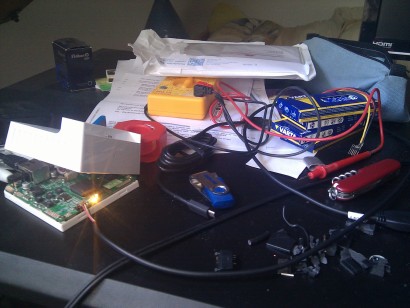Some years ago, there was a big craze when someone discovered that the Seagate DockStar could be hacked and flashed with your own software. The point was, it was a 25€ device with a quite decent ARM chip, Gigabit Ethernet and a load of USB ports. Overall, a good deal cheaper than the Raspberry Pi which cost me 42€ without power supply and case and does not seem to be any faster. So back in the day, I installed Linux on it and it was shelved.
Some week ago, I decided I could create an appliance out of it for streaming music at home. So, I wanted to update the software, updated the bootloader and… bricked the device (linking to Wikipedia because “brick” is such adorable slang with such a nice article). To unbrick it, I had to get access to the bootloader by building a special serial cable, for which I needed a CA-42 cable which is actually a cable to connect your Nokia cellphone to the PC. If you speak german, go ahead and click the link to Amazon, it has hilarious reviews that go like this: “no idea whether works with an actual cellphone, but it works fine for connecting my bricked device” which is the exact usecase that I have.
So after all, I cut off the Nokia connector and got three wires inside:
red/white/black which correspond to GND = black, TX = white, RX = red. I opened
the case and connected them with much fiddling to the appropriate pins on the
DockStar board and connected GNU screen to /dev/ttyUSB0 with 115200 baud
(previously I tested different terminals, screen is the only one I trust), lo
and behold it boots up and refuses to load the kernel that I installed in the
flash. So I copied Arch Linux ARM on a USB thunbdrive, booted from that and
installed a newer rescue system (Rescue V2) and then the unofficial V2.8.1, so
I don’t lock myself out again. On the USB thumbdrive I installed Debian Weezy
as main system.
After that was working, I plugged in a USB soundcard (don’t get the LogiLink USB soundcard it’s utter shit, I switched to another one) and installed PulseAudio:
1
| |
After you do that, you need to edit /etc/defaults/pulseaudio:
1
| |
Which starts PulseAudio in a mode in system mode. In /etc/pulse/daemon.pa I
added
1
| |
Which allows anyone to stream music to it, without authentication. To actually get music playing you need a different computer and specify the address of the PulseAudio server as environment variable (somehow most tutorials don’t mention it):
1
| |
which starts my media player outputting to the DockStar. Overall, tremendously cool but it stutters if I’m on WiFi because Pulse streams the music in uncompressed PCM format. PulseAudio, please, oh please fix ticket #366.
What’s yet left? Putting the DockStar in the living room and showing off!
